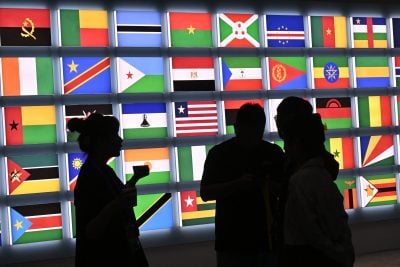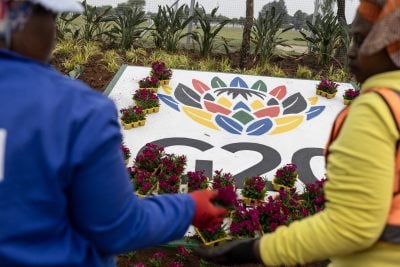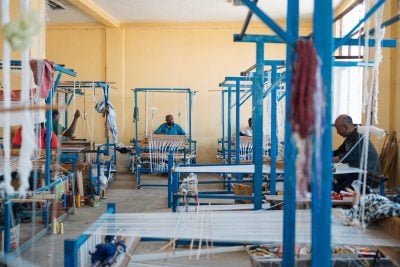During the IMF and World Bank spring meetings, alarms were raised about the capacity of low- and middle-income countries, including in Africa, to weather the combined storm of the fallout from Covid-19 and the Russia-Ukraine war, alongside continued vaccine hoarding, new sanctions and global supply chain challenges.
In managing this complex storm, the role of China was raised multiple times, especially by the European and American heads of the IMF and World Bank respectively, Kristina Georgieva and David Malpass.
Malpass was particularly scathing, stating that “China remains outside of the Paris Club, the main institution where debt-restructuring talks occur”. This comment reinforced a prevailing narrative that since China is “outside”, the country does not provide debt relief or restructuring, and that this impairs African countries’ economic stability.
However, most African policymakers know this inference is factually incorrect. China does engage in debt relief as well as restructuring. Analysts at my firm have calculated that over the period 2000-2018, China cancelled debt of at least 20 African countries, equivalent to 1.5% of all loans taken out across Africa from China, and in some cases such as Zambia more than other bilateral lenders. Analysis by the Rhodium Group in 2019 found 40 cases in which China had renegotiated or restructured debts, including of several African countries.
So if China is “outside”, how does this cancellation or restructuring happen? Would there be better outcomes for African debtors if China joins other creditors?
The World Bank or others seeking to be in the room with China is a classic case of wanting to be in control of the negotiation with the borrower – in this case, the African government.
In contrast, China is significantly less interested in the positions of other creditors. Why?
China’s approach to loans
The first reason is the way Chinese loans are agreed in the first place. While I simplify to some degree, this generally falls into two categories.
First, loan agreements are made with governments directly, linked to a specific project (such as a railway, road or energy project) with standard terms.
The expectation from China is the repayment will be raised from the country’s tax base, and often that the tax base of the country will endogenously increase due to the project (i.e. it is a public good). Thus, variables such as the pace of economic growth (and therefore Covid-19 or other shocks) matter a great deal to Chinese lenders in terms of repayment projections, rather than specific debt volumes or even domestic policy reforms. It is a feature of Chinese lending that policy reforms, which are seen as interference in domestic affairs, are not required for loans to go ahead.
The second way that Chinese banks agree loans is through a specific vehicle – a structure for “bankability”. This comes into play where a government is facing constraints on borrowing – such as a lack of credit rating, arrears, or even sanctions. Such governments are the equivalent of the “unbanked”. In such cases, Chinese banks show flexibility – and can agree to create “escrow accounts”, into which payments derived from either the project itself (such as a toll road) or another resource (such as commodities sold to China) can be paid.
Some interpret these accounts as a form of conditionality, but that is inappropriate from the borrowers’ perspective. I will never forget a conversation with a very jubilant senior African government representative that had just completed an escrow-based negotiation. His view was the new agreement was fantastic for his country and citizens. It would ensure the money wouldn’t be wasted – and instead be spent directly on sorely needed infrastructure.
A different form of analysis
These two types of loan agreements materially affect the way in which Chinese banks analyse debt challenges.
Overall, African loans make up a tiny portfolio of Chinese banks’ overall domestic and foreign debt. However, due to the two types of agreements, Chinese loans are fairly spread out across the continent. Excluding the top 10 African borrowers, loans since 2000 from China equate to an average $1bn each. China’s banks also tend to use standard grace periods, long maturities, and relatively low interest rates to avoid default, and do not – as multilaterals do – differentiate terms for countries at different income levels.
If, say, an African borrower has a problem, the first action Chinese lenders will take is to look at their own portfolio to see how they can manage the challenge. Of course, the banks hope to avoid default – and it’s certainly easier to do this if there is an escrow account – but as we see from the evidence from 2000-18, the banks do eventually extend or write-off limited amounts of their portfolio.
This is how China has built a reputation for negotiating debt in a bilateral manner. Chinese banks do not need other creditors in the room to make these decisions, assuming (respectfully) that borrowing governments can be trusted, just as China was when it was a borrower from others such as Japan.
Nor do Chinese banks expect to be accountable to other creditors about the loans they offer – each lender should know their own means, and the borrowing government has the sovereign responsibility for deciding whether to share or not share debt information with all parties, even its own citizens.
Antiquated arrangements
What does this all mean? And why does this matter now? It comes back to the spring meetings. While the major spending challenges African and other low- and middle-income countries are facing are crucial for China to recognise, the idea that China and other creditors need to be together to negotiate with each borrower one-by-one should be seen as a red herring by borrowers.
Indeed, an often-unknown fact is that in Paris Club negotiations, borrowers are not even in the room for the final discussion. After a presentation of their case, the borrower exits, and a French representative conducts shuttle diplomacy to inform the borrower of the outcome. China joining such an antiquated, colonial arrangement is highly unlikely to lead to better development finance for Africa.
That said, China is not a perfect lender. Much can be done to improve the terms and conditions of Chinese loans and even its debt relief and restructurings for African countries.
Borrowers should coordinate
There is a wide disparity in treatment and volumes. But this does not mean that creditors should coordinate. It suggests borrowers should coordinate – to exchange experiences and be in the room together. Indeed, that is a model borrowers could consider with respect to all creditors – the Paris Club, the IMF, World Bank and China included.
In 2019, deputy UN secretary-general Amina Mohammed used the phrase “flip the orthodoxy”. Today, we Africans need to flip the orthodoxy to reposition borrowers. Our experience with China can help.
Hannah Ryder is CEO of Development Reimagined, an African-led international consultancy based in China.
Want to continue reading? Subscribe today.
You've read all your free articles for this month! Subscribe now to enjoy full access to our content.
Digital Monthly
£8.00 / month
Receive full unlimited access to our articles, opinions, podcasts and more.
Digital Yearly
£70.00 / year
Our best value offer - save £26 and gain access to all of our digital content for an entire year!
 Sign in with Google
Sign in with Google 



